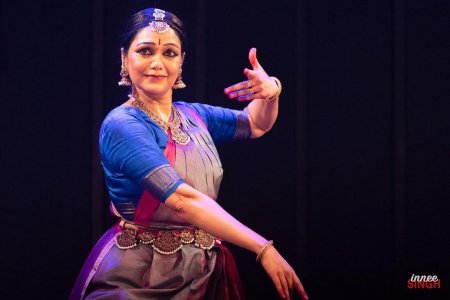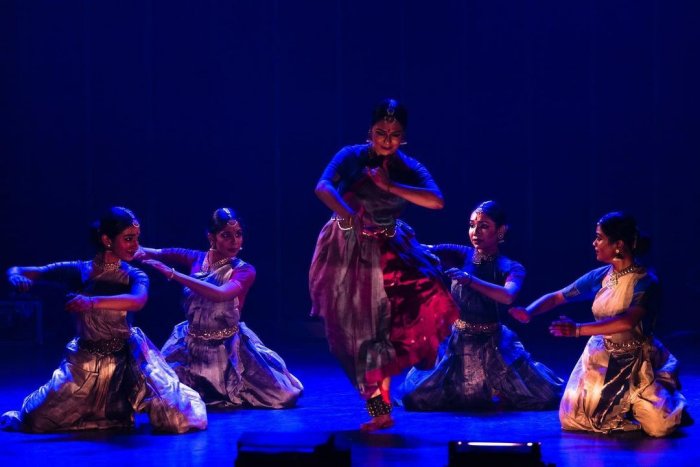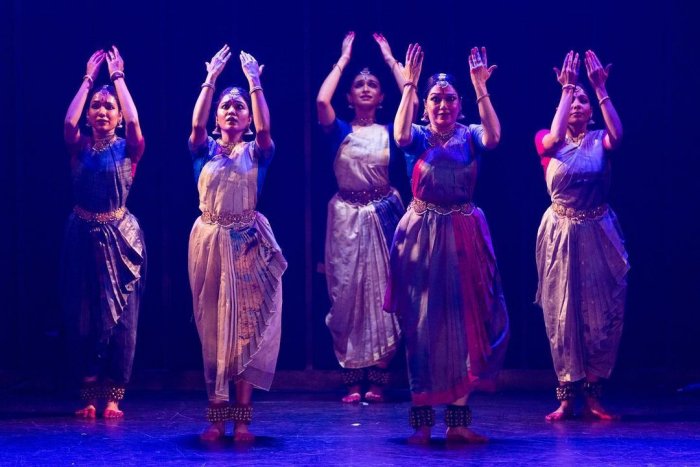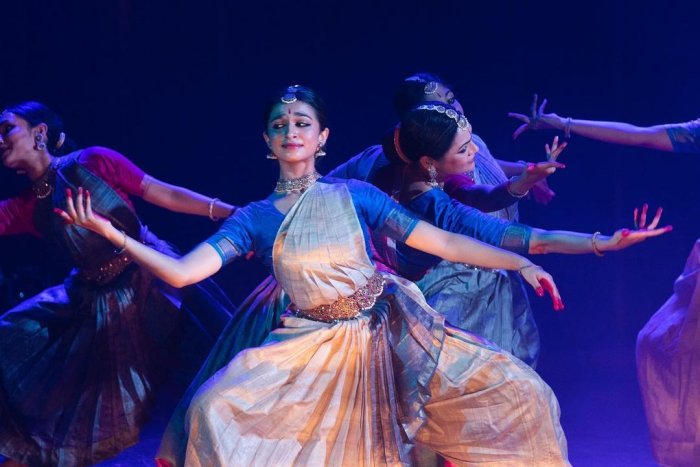
|   |

|   |
'New Dimensions to Margam' by Rama Vaidyanathan - AM Hari Shankar e-mail: hshankar252@gmail.com Photos: Innee Singh June 10, 2023 From Sadir to the format that we see today, Bharatanatyam has come a long way. Over the years, we have seen some illustrious dancers widening the dimensions of the dance form adding a bunch of new compositions and choreographies to the repertoire, some of which added a new fervour to the style but some were heavily criticized by purists. A recently held dance recital in the capital city yet again showcased how improvisations can be done within the traditional format, while still adhering to the well-established format.  Rama Vaidyanathan On a fine evening of last month, the Stein Auditorium, India Habitat Centre, New Delhi, was houseful before 30 minutes of actual commencement of the performance, but no wonder about it. The celebrated Bharatanatyam dancer Rama Vaidyanathan and her ensemble had their maiden performance of their new production 'New Dimensions to Margam', paying tribute to her beloved mother Madhavi Amma under the banner of Madhavi Foundation for Creative Excellence established by Rama and her siblings. This year's Madhavi Festival was jointly curated by Kri Foundation of Dr. Arshiya Sethi, scholar and cultural visionary, who graced the evening by adorning the role of the compere also. Gloria. F. Berbena, Minister Counselor for Public Diplomacy, US Embassy, New Delhi, graced the occasion as the guest of honour. The initial item was inspired by Panchaka Mallari of Nadaswaram tradition, where Rama incorporated the 8th verse of Mukundamala, an 800 AD text by seventh of twelve Vaishnavite alwars, Kulashekara Alwar, the then Chera King of present day Kodungalloor of Kerala. "Chintayami Harimeva santhatham, Manda manda asitha aananaambhujam, Nandagopa tanayam paraathparam,. Naaradaathi muni vrindha vanditham, Harimevam vanditham santhatham"- Here, Kulashekara Alwar says he is always meditating on Hari who is worshipped by celebrated saints like Narada, the destroyer of all sins and this Hari is none other than Krishna who came to bless us all as son of Nandagopar of Vrindavan. This verse set in Gambhira Nattai in a format of Mallari in different tempos and incredible pattern movements gave an outstanding takeoff for the group performance keeping the audience engaged in counting khanda triputa talam. Following this was the 9th verse from the same text, "Kara charana saroje kanthimaan netra mine, Shrama mushi bhuja vichi vyakule agadha marge, Hari sarasi vigahyapiya tejo jalaugham, Bhava maru parichinnah klesham aadya tyajaami". This verse in Gaula suddenly took the audience to a meditative mood where the composer says as he contemplates in the Krishna consciousness, he is identifying himself taking a deep dip in the cool pond (Hari Saras) and equates the hands and feet of the Lord to the blooming lotuses, the fishes to his lotus eyes and the waves like the limbs of the Lord inviting to immerse himself in the pond. The composer uses the literary device of comparing his divine experience as if a traveller in the arid desert sighting a cool pond, relieving him of all his sufferings and afflictions. The dancers well portrayed the essence of this verse. Kudos to the light designer Gyan Dev Singh for creating a pond like image using his illumination brilliance which radiated among the audience to understand the choreographic aesthetics and the deep meaning of the composition.   The second choreography, "Jhuk aayi re badariya saawan ki", a 30 minute varnam set in Ragamalika and adi talam in Hindi dialect from Mirabai's Padavali was my personal favourite. This particular piece was apt for the large number of non-South Indians among the audience and which also serves as the testimony for Rama's wide acceptance and this much gathering for her recital. Sensitive towards the need and level of audience is surely a success mantra for her. Here, Mirabai compares the huge heavy dark clouds as elephants over which her Lord, Krishna is riding. She says like a dry land yearns for a heavy rain, her heart also yearns for her Lord. "Nanhi nanhi boondiyaan meha barse..." - As the rain drop touches her, she feels it like Krishna's golden touch. The glimpse of her narrations before performing made the concert easily congenial for every rasika. The footwork and the movements she portrayed was so picturesque that the audience felt there was water logging on stage, giving a sense of utter joy of rain and thunderstorm, created by her accompanying artistes, a marvel to witness. Following varnam was a Marathi abhang,"Vithala namaachi shaala bharli" by Jagadish Khebudkar portraying innocence of young children, the ardent devotees of Panduranga of Pandharpur, Maharashtra. Set in Hamsanandi ragam and talam adi, this item enthralled the audience with a Bhakti-Bhajana tradition with many from the audience applauding in joy. This disciples only choreography had a special last entry of the Guru herself asking as in the role of a mother reminding these children that they hadn't had food, bath, rest, anything for past these many hours chanting and praising Vithala and she asks these merry children to go back home. One last child, very reluctant to listen to her mother, created laughter among the audience. The way Rama incorporated jatis in-between the Marathi abhang without compromising both the abhang's bhakti mood and the grammar of her repertoire was remarkable. From Marathi abhang to Rabindra Sangeet in Bengali, "O je mane na maana...", was a love song composition by the ace poet Rabindranath Tagore set in ragam Bhairavi, taal dadra, where the Nayika lovingly cajoles her lover not to leave her house. He says the night is gone and the lights have dimmed, but she implores Na Na Na. He further says the spring hastens through flower bushes in the crazy gust of wind and insists to let him leave, but she stands at the doorway and implores no, no, no. This popular composition rendered by the vocalist so soothingly and with the melodious sounds of khanjra alone gave an opportunity for the audience to groove in a cozy romantic reminiscence after the powerful three items preceding this. The very idea of portraying a door on the backdrop of the stage was a thoughtful insight by the dancer, effectively arranged by the light designer, which made the transition of the mood of the audience much more effective.  The concluding item was a group choreography based on Tamil verses from Tirumular's Tirumandiram text connecting our breath cycle to the cosmic dance of Lord Shiva, set in Talamalika. The piece showcased the articulating diverse nritta patterns and strong footwork with reverberating beats of the mridangam along with pauses for the audience to imbibe the higher vibrations of Shiva consciousness. Rama's disciples had an inimitable sense of coordination and stage space management. All the five choreographies' music inputs were done by Sudha Raghuraman, Dr.S.Vasudevan and K.Venkateswaran with the rhythmic inputs by Late K Sivakumar. The appealing aspect about the whole performance was the inclusion of young musicians to the orchestra team with nattuvangam and khanjira by Ashwin Subramanian, vocal support by Anugrah Lakshmanan, violin by Vishwesh Swaminadhan and mridangam by Rama's daughter Sannidhi Vaidyanathan, all new faces in the Delhi Art Circle, exalting the concert to the next level. Sannidhi's talent was highly showcased in the first and last piece exploring various jathis and her playing effortlessly. The senior disciples who joined with Rama this evening were Kavya Ganesh, Reshika Shivakumar, Shubhamani Chandrasekhar and Vaishnavi Dhore, all excellent dancers soundly stating their guru's style and lineage. This new production is all set for a US tour shortly. It is noteworthy how the technical advances like stage lightings can be explored for more effective interpretations and communication. Credits to Gyan Dev Singh for the light designing. Rama was successful in all these aspects and at the same time exploring Bharatanatyam beyond the language boundaries ranging from Sanskrit to Hindi to Marathi to Bengali Rabindra Sangeet to Tamil gives a new fresh outlook, pulsating renewed energies for Indian classical dance. Her well trained disciples with the new group of young artistes on the accompaniments and a good majority of the audience being young, gives a greater hope for the future of Bharatanatyam.  A M Hari Shankar, an art enthusiast, percussionist and a connoisseur of Indian Classical Arts is a Biologist-Educationist by profession, based in Delhi. Recipient of the Ministry of Culture Scholarship, his areas of interest include Life Science, Indian Arts and Spirituality. Some of his articles have been published in leading journals and newspapers. |